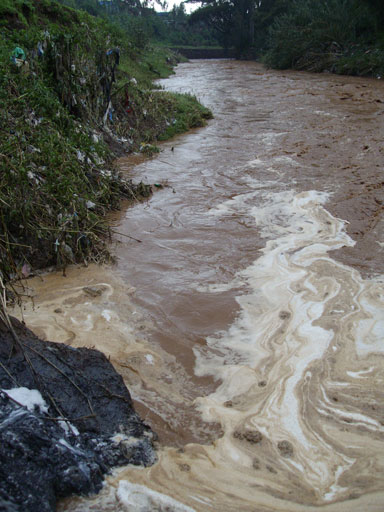7.5.1 Water pollution
Water pollution can affect surface water such as rivers and lakes, soil moisture and groundwater in aquifers, and the oceans. As you know from Study Session 4, the actions of the water cycle connect all these different reservoirs of water. For example, a polluted river will discharge into the ocean and could damage the marine environment. However, the volume of water in the ocean can disperse and dilute the pollutant so that its worst effects are only felt near the mouth of the river.
Water pollution is characterised by the presence of excess physical, chemical or biological substances that change the qualities of the water and are capable of causing harm to living organisms. We mentioned earlier that natural or unpolluted water is colourless, odourless and transparent. Water that tastes or smells bad or is cloudy can be said to have the symptoms of water pollution. However, some water pollutants cannot be seen or tasted, for example some chemicals, such as pesticides, and most of the micro-organisms that cause waterborne diseases. So, water pollution involves more than just the appearance of the water. Polluted water should not be used for drinking, washing, bathing or agriculture. If polluted water is used by humans, then it can adversely affect the body in different ways, depending on the type and concentration of pollutant.
You also read in Study Session 4 that most rivers and streams in Ethiopia contain significant quantities of suspended solids that are carried along in the flow and make the water look brown in colour, especially in the rainy season (Figure 7.9). Most of the solids are fine particles of soil that have been washed into the river from surrounding land by rain, often following cultivation or construction work. Large quantities of solids in the water can reduce light penetration into the water which can affect the growth of plants.

Biological water pollutants are micro-organisms that are harmful to humans and other forms of life. They are responsible for many different waterborne diseases. The original source of these pollutants is people or animals already infected with the micro-organisms concerned. If faeces from infected people are not correctly contained and treated, the pollutants can get into surface and groundwater. The main groups of biological pollutants are bacteria, viruses, protozoa and helminths (worms).
Chemical water pollutants take many different forms depending on their source. They include plant nutrients (compounds of phosphorus and nitrogen) used as fertilisers which, as you read earlier, can be washed from fields into rivers. These nutrients are also produced by the breakdown of human and animal wastes and are common pollutants of surface waters.
Chemical pollutants also include heavy metals, pesticides and other persistent pollutants. Heavy metals are a group of toxic chemical pollutants that contain compounds of persistent metals such as mercury, cadmium, lead and chromium. The presence of heavy metals in water in excess of acceptable levels can cause illness and death among animals and humans if consumed through drinking and food (Zinabu and Pearce, 2003).
Persistent organic pollutants (POPs) are also toxic to humans and wildlife. They include many different synthetic organic chemicals manufactured for use as pesticides and in industrial processes, e.g. DDT, aldrin and PCBs (polychlorinated biphenyls). Many of these persistent chemicals have been banned in some countries. Their persistence in the environment creates specific problems that are described in Study Session 8.
7.5 Sector of the environment affected by pollution
